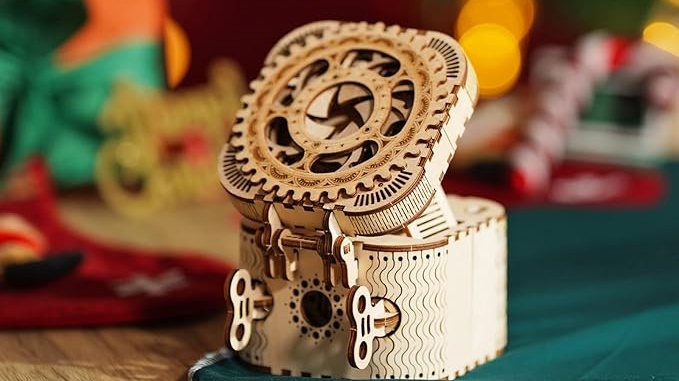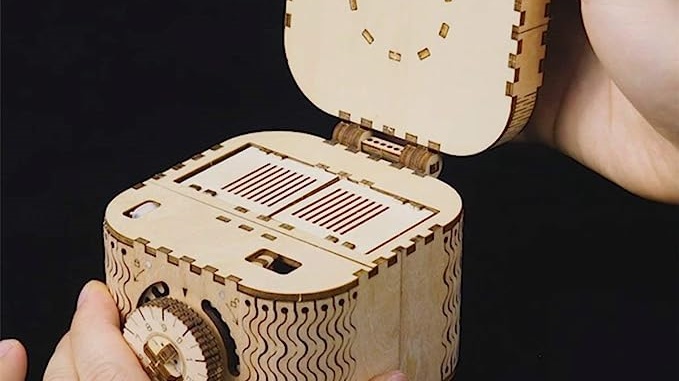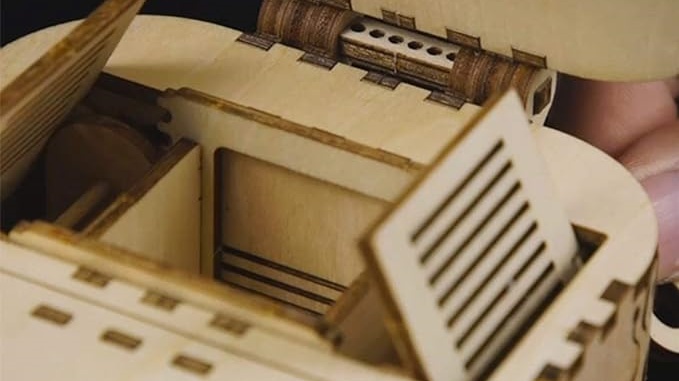
How To Add Storylines To Your Wooden Jigsaw Puzzle: A Creative Guide
Imagine a wooden jigsaw puzzle where each piece is more than a part of an image; it’s a chapter in a captivating story waiting to

When choosing the right puzzle box(wooden puzzle boxes or paper one) for your toddler, it’s essential to consider the materials’ properties and how they align with your child’s developmental needs and safety.
Wooden puzzle boxes are renowned for their sturdiness and natural appeal. Crafted from durable materials like maple or birch, these puzzles withstand the test of time and the energetic play of toddlers.

The sensory experience offered by wooden puzzles—feeling the grain of the wood, smelling the subtle natural scent—can stimulate a child’s sensory development. These tactile interactions are not just about solving a puzzle; they’re about connecting with the natural world.
However, the choice of wood and the manufacturing process are crucial. Parents should look for puzzles made from sustainably sourced wood and finished with non-toxic, child-safe varnishes to ensure the highest safety and environmental standards are met.
Paper puzzle boxes, typically made from thick, reinforced cardboard, offer a lightweight and colorful alternative to wooden puzzles.
The vivid imagery and diverse themes available in paper puzzles are particularly appealing, capable of capturing a child’s imagination and encouraging cognitive development through storytelling and role-play.
These puzzles are more accessible and can be easily replaced, allowing for a variety of themes and challenges as the child grows.
However, their lifespan is shorter; they are prone to wear and tear, especially in the hands of an enthusiastic toddler. For paper puzzles, the key is quality—thicker cardboard and durable prints can significantly extend the life of the puzzle.
Safety is paramount when selecting a puzzle box for a toddler. Wooden puzzle boxes should be sanded smoothly to avoid splinters, with non-toxic finishes to ensure they’re safe for children who may put pieces in their mouths.
Similarly, paper puzzles should be made from sturdy cardboard that doesn’t easily tear into small, swallowable pieces.
Regardless of material, all puzzle boxes should be large enough to not pose a choking hazard and designed with safety in mind.
Parents are encouraged to regularly inspect the puzzles for any signs of wear or damage that could compromise safety.
Both wooden and paper puzzles offer unique benefits that can aid in a toddler’s development, from motor skills to creativity.

The tactile nature of wooden puzzles supports sensory development and fine motor skills. Handling wooden pieces helps toddlers develop grasp control and dexterity, crucial for writing and other precise activities later on.
The act of fitting wooden pieces into their slots also enhances problem-solving skills and spatial awareness.
In contrast, paper puzzles, while offering less tactile feedback, still promote motor skills through the manipulation of pieces.
The lighter weight of paper puzzles can be an advantage for younger toddlers, offering less resistance and easier handling.
While wooden puzzles might seem simplistic in design, they often encourage imaginative play. A simple animal-shaped puzzle piece can inspire stories and adventures beyond the puzzle itself.
Paper puzzles, with their detailed scenes and characters, directly feed into a child’s imagination, encouraging narrative thinking and creativity.
These puzzles can act as a springboard for discussions about the world, introducing concepts and themes in a fun, engaging manner.
For toddlers, every puzzle piece can be a character or element in their imaginative play, blending educational value with creative storytelling.
Durability is a significant factor in choosing between wooden and paper puzzles. Wooden puzzles are investment pieces; they are designed to last and can endure the enthusiastic play of multiple children over the years. This durability makes them a sustainable choice, reducing waste and offering ongoing value.
Paper puzzles, while initially less durable, have seen improvements in quality.
High-grade cardboard and advanced printing techniques have increased their lifespan, making them a more viable option for parents looking for variety and educational content.
However, the inherent nature of paper means these puzzles will never match the longevity of their wooden counterparts.
The impact on the environment and your wallet are also crucial factors in the decision-making process.
The environmental impact of toys is a growing concern for many parents. Wooden puzzles, made from sustainable, responsibly sourced wood, offer an eco-friendly option that doesn’t compromise on quality or safety. They biodegrade naturally and minimize environmental impact.
Paper puzzles, when made from recycled materials and printed with eco-friendly inks, also present a green choice.
However, their shorter lifespan and the need for frequent replacements can add to environmental waste, a factor worth considering for eco-conscious families.
From a budget perspective, paper puzzles often present a more affordable upfront cost, providing the opportunity to introduce a variety of themes and challenges to a child at a minimal expense.
However, the need to replace worn-out or damaged puzzles can add up, potentially outweighing the initial savings.

Wooden puzzles, with their higher initial price point, offer long-term value through their durability and the ability to be passed down or resold, making them a worthwhile investment for families looking for quality, sustainable toys.
The choice between wooden and paper puzzle boxes for toddlers hinges on a balance of factors including durability, educational value, safety, and environmental impact.
Wooden puzzles offer a tactile, durable option that supports sensory development and fine motor skills, making them a long-lasting addition to any toy collection.
Paper puzzles, with their vibrant themes and creative potential, provide a cost-effective way to engage a child’s imagination and cognitive skills, despite their shorter lifespan.
Ultimately, the best choice depends on your child’s needs, your environmental and economic considerations, and the type of play experience you wish to provide.
Whether you opt for the classic appeal of wood or the colorful world of paper, selecting the right puzzle box can provide hours of educational fun for your toddler.
How can I test the durability of a puzzle box before buying it?
To assess the durability of a puzzle box, check the material thickness and construction quality. For wooden puzzles, look for solid wood with a smooth finish and rounded edges. For paper puzzles, opt for thick, reinforced cardboard. If shopping online, read customer reviews focusing on longevity and resistance to wear.
Are there any specific safety certifications I should look for in puzzle boxes for toddlers?
Yes, look for safety certifications that indicate non-toxic materials and child-safe designs. Common certifications include ASTM (American Society for Testing and Materials), CE (Conformité Européenne), and CPSIA (Consumer Product Safety Improvement Act) compliance. These certifications ensure the puzzle boxes meet stringent safety standards.
Can wooden and paper puzzle boxes be recycled once they’re no longer usable?
Wooden puzzle boxes made from untreated, natural wood can often be recycled or composted, though any painted or varnished surfaces may limit recycling options. Paper puzzle boxes, especially those made from cardboard, are typically recyclable, provided they haven’t been contaminated with food, liquid, or non-paper elements like plastic coatings.
How can I clean and maintain wooden and paper puzzle boxes to extend their lifespan?
For wooden puzzle boxes, wipe them with a damp cloth and mild soap for cleaning, and avoid soaking them in water. You can also apply a natural wood conditioner to keep the wood from drying out. Paper puzzle boxes should be kept dry and clean; use a dry, soft brush to dust them off. Avoid using damp cloths on paper puzzles to prevent warping and peeling.
Are there eco-friendly alternatives to traditional wooden and paper puzzle boxes that still offer educational value?
Yes, there are eco-friendly alternatives like puzzles made from recycled plastics or sustainable materials like bamboo. These options provide the same educational benefits as traditional wooden and paper puzzles, often with a lower environmental impact. Look for products that emphasize sustainability in their materials and manufacturing processes to find the most eco-friendly options.


Imagine a wooden jigsaw puzzle where each piece is more than a part of an image; it’s a chapter in a captivating story waiting to

Embark on a journey to unravel the nuanced distinctions between two beloved genres of puzzles: plain wooden puzzles and 3d wooden puzzles. In this comprehensive

Imagine your wooden jigsaw puzzle not just as a piece to be solved but as an interactive journey that engages all your senses. This guide

In the enchanting world of puzzle assembly, the choice of storage can be as personal and complex as the puzzles themselves. Wooden puzzle boxes whisper

Imagine a wooden jigsaw puzzle where each piece is more than a part of an image; it’s a chapter in a captivating story waiting to

When choosing the right puzzle box(wooden puzzle boxes or paper one) for your toddler, it’s essential to consider the materials’ properties and how they align

Embark on a journey to unravel the nuanced distinctions between two beloved genres of puzzles: plain wooden puzzles and 3d wooden puzzles. In this comprehensive

Imagine your wooden jigsaw puzzle not just as a piece to be solved but as an interactive journey that engages all your senses. This guide
Copyright © 2024 woodcraft3dpuzzles. All Rights Reserved.